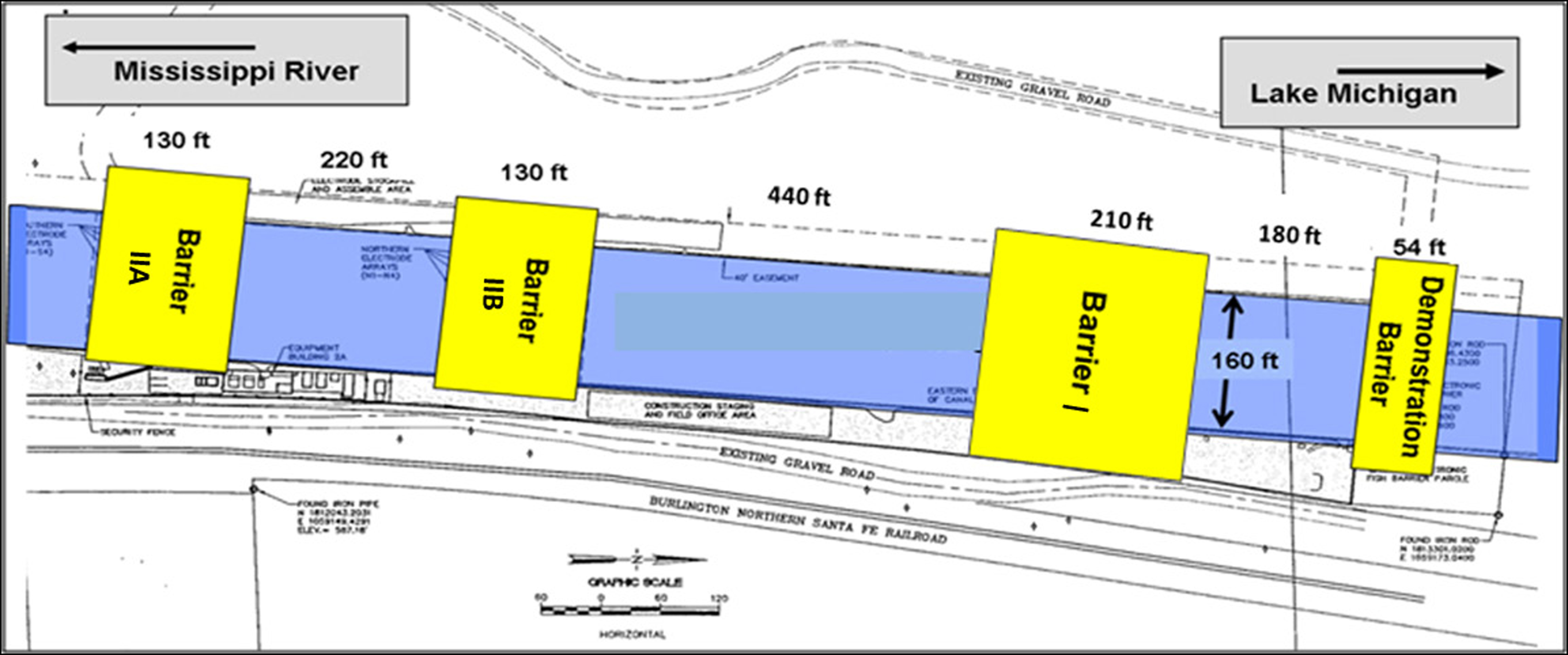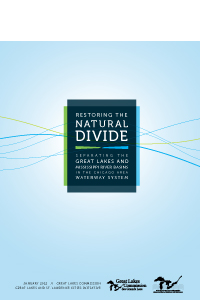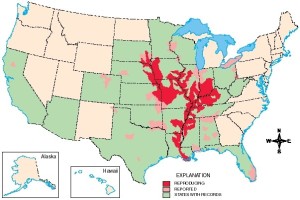The Asian Carp Threat To The Great Lakes – 10 Things You Need To Know
On November 8th, 2012, a public forum was held in Toronto, Ontario, in regards to the Asian carp threat to the Great Lakes. It was a remarkable gathering of the experts that are working to prevent this problem, and they shared a wealth of information. Here are 10 things you need to know about the Asian carp threat to the Great Lakes.
1. How Asian carp were introduced to the United States and became a problem.
Asian Carp were imported to the United States in 1970s for use in aquaculture operations. Flooding allowed their release into the Mississippi River system. The first wild captures of Asian Carp were in the 1980s. They quickly moved through the river system and can now be found in the Illinois River which has a direct link to the Great Lakes through the Chicago Sanitary and Ship Canal. One important note is that the Asian Carp population in this system does not appear to have progressed towards Lake Michigan since 2007. Therefore, they are a huge imminent threat, but the hope is that there is time for systems to be implemented to keep them out of the Great Lakes.
There is no evidence of an established Asian carp population in Canada at this time.
2. Knowing how to identify Asian carp is essential in preventing them from entering the Great Lakes, and for reporting any sightings.
It is important to be able to identify and distinguish the Asian Carp species from our own native and naturalized species. Bighead and silver carp are the two species getting the most attention, but grass and black carp are also invasive species.
This video from the Asian Carp Regional Coordinating Committee’s (ACRCC) website gives a great overview of how to ID these fish.
The Ontario Ministry of Natural Resources has compiled an excellent fact sheet on Asian carp which includes tips for identifying juvenile Asian carp.
3. The biology of Asian carp is what makes them difficult to eradicate.
Asian carp are voracious eaters, grow quickly and reproduce at an alarmingly fast rate. Bighead and silver carp consume 5-20% of their body weight each day. At the Asian Carp Public Forum, it was estimated that these fish can live up to 15 years. It has been argued that the Great Lakes climate would be too cold for these fish to survive but their behavior suggests they may be better suited to it. It was noted by the USGS that these fish feed later into the year than most native species, suggesting the cold temperatures do not slow them down.
4. The Threat
So what is the actual threat to the Great Lakes? Plain and simple, Asian carp destroy ecosystems and biodiversity. The Asian carp have no natural predators in North America. The bighead, in particular, is a plankton eater that is known adapt to quickly to new environments and new food availability. The carp would out complete bait fish and species like yellow perch for plankton, leading to decline, and possibly the demise of those species. When that happens, the other fish populations will decline. It is true that some fish species could feed on the juvenile Asian carp, but the carp grow so quickly that this predation will have no effect.
Sport fishing in Ontario makes up two-thirds of all money brought in by fishing. As point out by Terry Quinney of the OFAH, not only is there a tremendous economic benefit to sport fishing, but there are numerous benefits to our health and well-being. Anglers volunteer hours of their time to habitat restoration and fish stocking, as well as the re-introduction of native species like the Atlantic Salmon. Sixty years ago we did not have these benefits thanks to another invader – the sea lamprey. An Asian carp invasion will return us to that lack of benefits derived from the Great Lakes.
 Silver carp are the ones seen in pictures and watched on YouTube video – the sound of boat motors causes them to jump out of the water. As a side note, this fact has lead to the hypothesis that they are sound sensitive and there are tools being created that take advantage of this, including a water gun. The boating hazard caused by these fish is a very real problem.
Silver carp are the ones seen in pictures and watched on YouTube video – the sound of boat motors causes them to jump out of the water. As a side note, this fact has lead to the hypothesis that they are sound sensitive and there are tools being created that take advantage of this, including a water gun. The boating hazard caused by these fish is a very real problem.
5. There are a tremendous number of governments and organizations working together to address this threat.
At the Asian Carp Public Forum it was continuously emphasized that the key to managing and preventing this threat is to work in partnership. The Asian Carp Regional Coordinating Committe (ACRCC) is the main partnership that is taking measures to prevent the introduction of Asian carp to the Great Lakes. The people involved in this project have an incredible will to prevent the threat to the Great Lakes from being realized. Some members of this partnership include:
- Invasive Species Centre
- Great Lakes and St. Lawrence Cities Initiative (GLSLCI)
- Ontario Ministry of Natural Resources (OMNR)
- Fisheries and Oceans Canada (DFO)
- U.S. Fish and Wildlife Service (US FWS)
- Council on Environmental Quality (CEQ)
- Great Lakes Fishery Commission (GLFC)
- Illinois Department of Natural Resources (IL DNR)
- Ohio Department of Natural Resources (Ohio DNR)
The Federal Governments on both side of the border are committed to mitigating this threat to the Great Lakes. One very important note is that much of the funding for this work has come from the Great Lakes Restoration Initiative (GLRI). It was mentioned more than once at the Forum that there could be some major difficulties once this funding runs out.
The Great Lakes and Mississippi River Basin Interbasin Study (GLMRIS) is a study that involves many partners, principally the US Army Corps of Engineers, and will:
explore options and technologies, collectively known as aquatic nuisance species (ANS) controls, that could be applied to prevent ANS transfer between the Great Lakes and Mississippi River basins through aquatic pathways.
This study will play a vital role in fighting the Asian carp threat, as well as the threat of all invasive species.
6. The Risk Assessment study a provides a bleak outlook in the impact to the Great Lakes if the invasion occurs.
The DFO’s Risk Assessment study shows that the most likely path of arrival would be through the Chicago Area Water System (CAWS). It found:
Analyses of tributaries around the Canadian Great Lakes and the American waters of Lake Erie indicate that there are many suitable tributaries for bigheaded carp spawning. Should bigheaded carps establish in the Great Lakes, their spread would not likely be limited and several ecological consequences can be expected to occur.
It was found that 57 Canadian tributaries would provide suitable habitat and spawning locations for Asian carp. Lakes Michigan, Huron and Erie have the highest risk, followed by Lake Ontario, then Lake Superior. Lake Erie is seen as a mecca for these fish due to its shallow depth and vast amount of spawning habitat. It is thought that Asian carp will be happy in Lake Erie and be less likely to seek out new water as quickly, but the experts believe Asian carp would take over all of the Great Lakes within 20 years of their entry to the system.
The Assessment found that Canada is not too cold for these fish, and that they will actually thrive in the presence of zebra mussels, instead on competing directly against them. As well, the study found it could take as few as 10 females and 10 males to establish a population.
The study paints a bleak picture of what will happen should Asian carp move into the Great Lakes. It emphasizes that prevention is key.
7. There has been, and continues to be, an incredible amount of monitoring being conducted in the Great Lakes.
Monitoring for Asian carp is being conducted in many ways. Core monitoring – the electrofishing and netting that DNRs and MNRs already carry out to monitor the fisheries – is continuing. The core monitoring programs already cover a vast amount of water and account for many, many hours of monitoring.
When eDNA testing turns up positive hits, the DNRs and MNRs role out a rapid response team to cover as much water in the area of the positive test as possible. This takes the form of ‘run and gun’ electrofishing, whereby boats herd the fish into nets. There are increased netting operations, as well.
Commercial fisherman are also recruited to aid in monitoring for Asian Carp.
While five bighead carp have been caught individually over a span of about eight years in Lake Erie (the last being in 2003), the recent monitoring has turned up no Asian carp, and has provided no proof of an established Asian carp population. It was noted at the Forum that if a silver carp population was present, it would likely be known by the presence of flying fish.
8. eDNA is considered to be a useful tool, but as of yet, no one is sure exactly what it indicates.
 Testing for eDNA (environmental DNA) is part of the monitoring programs in both Lake Michigan and Lake Erie. It involves the simple collection of water to be tested at a lab for the presence of Asian carp eDNA. It is thought that eDNA could be used as an early indicator for the presence of Asian carp in a water system, and could be used as a real-time indicator. However, it currently has a minimum two week testing turn around, according to the ACRCC. Ohio actually had almost a year long wait to find out the results from their water collections in 2011.
Testing for eDNA (environmental DNA) is part of the monitoring programs in both Lake Michigan and Lake Erie. It involves the simple collection of water to be tested at a lab for the presence of Asian carp eDNA. It is thought that eDNA could be used as an early indicator for the presence of Asian carp in a water system, and could be used as a real-time indicator. However, it currently has a minimum two week testing turn around, according to the ACRCC. Ohio actually had almost a year long wait to find out the results from their water collections in 2011.
In the summer of 2012, after finding out about the positive eDNA hits from 2011, Ohio DNR undertook extensive monitoring, including more eDNA samples in Sandusky Bay and River, as well as Maumee Bay and River. The results of this testing indicated 20 positives out of 150 samples in Sandusky, and 3 positives out of 350 samples in Maumee. Still, no Asian carp were actually found despite the intensive monitoring.
The ACRCC has funded the eDNA Calibration Study, or ECALS, in an effort to better understand eDNA. For a list of the study’s objectives, visit here. The study is looking at possible vectors, other than live fish, that would account for the presence of Asian carp eDNA in the Great Lakes. One possibility is that the eDNA could be transferred in bird excrement.
The current testing identifies short stands of eDNA. Short strands of eDNA take longer to break down than long strands of eDNA. It is possible that these short strands remain viable long enough to be transported a great distance. There is a focus on creating tests that will only identify the long strands of eDNA, which are thought to be a better indicator of the presence of Asian carp, due to their shorter period of viability.
The ECALS are quite fascinating and the results of the testing being carried out by the USGS should provide some excellent information for the understanding and application of tools in the fight against Asian Carp.
The bottom line at present, is that it is not known if a positive eDNA hit necessarily indicates the presence of live fish, but this will be very useful tool once better understood.
9. The most effective means of prevention at this point appear to be barriers.
There are currently three Electrical Fish Dispersal barriers in the Chicago Sanitary and Ship Canal, the gateway to the Great Lakes. The barriers are operated by the US Army Corps of Engineers (US ACE). Three barriers are necessary to provide redundancy – if one experiences a power outage, the other two pick up the slack. If one is closed for maintenance, the other two are still operational. The barriers all have generators in case of a catastrophic power outage. For further details on the barriers, see the US ACE site.

This diagram shows the electrical barriers in the canal. Once Barrier I is built, the demonstration barrier will be taken offline.
At the Forum, a video showed a test net taking gizzard shad through the barrier. Once the fish hit the narrow array they were stunned and fell backwards, away from the barrier (and Lake Michigan), with the flow of the water. There are 201 tagged fish in the area of the barrier. To date, according to Lt. Col. James Schreiner of the US ACE, there have been 6 million hits and not one tagged fish has crossed the barrier.
Some question the efficacy of the barrier as an adult Asian carp was found above the barrier but, while that is a concern, it is believed that this fish was likely released by a human.
While the electrical barrier appears to effective at this point, the idea of restoring the natural divide by separating the Great Lakes and the Mississppi  River Basin has been proposed as a key permanent solution. A physical barrier that could separate the water bodies and prevent the flow of aquatic invasive species would be, according to the study Restoring the Natural Divide, feasible and can be accomplished in a way to maintain and enhance the uses of the Chicago waterway system. The costs to achieve this range from $4.5 billion to $9.5 billion. While those numbers seem quite high, they pale in comparison to what it would cost in damage and eradication attempts if Asian carp reach the Great Lakes.
River Basin has been proposed as a key permanent solution. A physical barrier that could separate the water bodies and prevent the flow of aquatic invasive species would be, according to the study Restoring the Natural Divide, feasible and can be accomplished in a way to maintain and enhance the uses of the Chicago waterway system. The costs to achieve this range from $4.5 billion to $9.5 billion. While those numbers seem quite high, they pale in comparison to what it would cost in damage and eradication attempts if Asian carp reach the Great Lakes.
10. Education of the public is the single most important tool in the prevention of Asian carp spread. Human action is the wildcard.
In Ontario, it is illegal to possess live Asian carp. The Ontario MNR and Canadian Border Services Agency take precautions to prevent live Asian carp from entering Ontario at the border. The OMNR travels to fish markets to educate sellers on what fish they are not allowed to possess, leaving them with identification charts for assistance They also investigate tanks, freezers, paperwork, and trucks at these facilities.
Despite the hard work of these agencies, there are unscrupulous people continuing to try and get live Asian carp into the province. Tanker trucks will reach the border empty of water and declare the fish to be dead. Unfortunately, these carp can survive 14 to 16 hours out of water. A test that is done at the border to determine if the fish are actually dead involves filling a bucket with water and throwing 6 to 7 ‘dead’ fish in it. If they start swimming after a few minutes, then someone broke the law.
The human threat is that a truck transporting live Asian carp will overturn and spill it’s load into our waterways. Or someone will decide to release a fish into the waterway. Agencies have plans in place for dealing with these threats, but they can only respond if they know it has happened.
In order to circumvent these possibilities it is necessary to educate people, especially anglers. Post notices in tackle shops and bait shops – identification charts, informational brochures, a listing of fines. Based on angler participation and interest at the Forum, there are many people looking to help and prevent a problem, but the information is not being delivered to them.
Final Note
Asian carp represent a very real and imminent threat to the Great Lakes. Only continued partnerships, funding, resource allocation, public information, and political will from all levels of government will keep our waterways safe. Remember, an ounce of prevention is worth a pound of cure.



